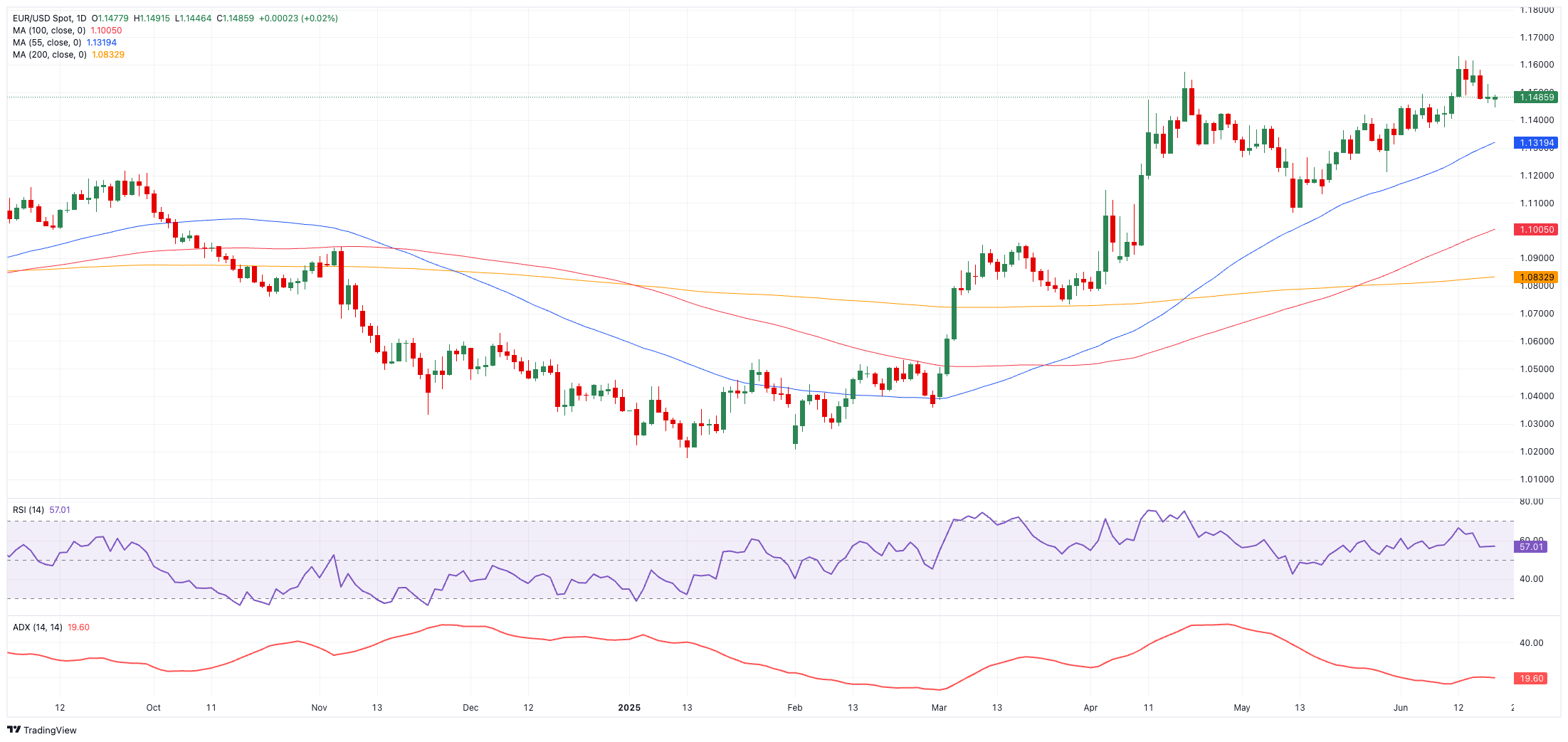
- EUR/USD traded in a vacillating fashion below the 1.1500 threshold.
- The US Dollar clocked slight gains amid the resurgence of the risk-off mood.
- The US markets remained closed due to the Juneteenth federal holiday.
On Thursday, the Euro (EUR) maintained its position against the US Dollar (USD) around its closing levels from Wednesday.
Indeed, EUR/USD navigated a narrow range in the sub-1.1500 region, while the US Dollar Index (DXY) rose marginally, at some point surpassing the key 99.00 barrier.
War and tariffs stoke market volatility
Heightened tensions in the Middle East have offset any positive momentum from US-China trade talks, while the July 9 deadline for “Liberation Day” tariffs continues to weigh on sentiment. The recent escalation between Israel and Iran has sparked speculation about potential US intervention in the conflict.
Policy path part ways
Following its June meeting, the Fed unanimously opted to keep rates at 4.25–4.50% and revised its quarterly forecasts higher for both unemployment and inflation, reflecting tariff-related risks.
Policymakers remain split on future moves, however: two foresee a single cut in 2025, seven expect no reductions despite a median dot-plot call for 50 bps of cuts by year-end, and eight anticipate rates ending the year between 3.75% and 4.00%.
Conversely, the European Central Bank (ECB) reduced its Deposit Facility Rate to 2.00% earlier this month, adopting a cautiously hawkish stance, with President Lagarde dismissing the possibility of further easing in the absence of a significant decline in external conditions.
Speculative sentiment favours the Euro
Non-commercial interest in the single currency has surged, with CFTC data through June 10 showing open interest near multi-year highs and net long positions at fresh peaks. Commercial hedgers, by contrast, have increased their short exposure, signalling institutional caution.
Through the technical window
EUR/USD faces immediate resistance at the June 2025 high of 1.1631, followed by the October 2021 peak at 1.1692 and the 1.1700 milestone.
On the downside, support sits at the 55-day SMA at 1.1323, then the weekly trough of 1.1210 and the monthly base of 1.1064.
The Relative Strength Index (RSI), which is near 57, suggests a bullish tilt, while the Average Directional Index (ADX), which is around 20, indicates only modest trend strength.
EUR/USD daily chart

Moving forward
Next on tap on the domestic calendar will be German Producer Prices, preliminary June Consumer Confidence, and the ECOFIN meeting on June 20.
ECB FAQs
The European Central Bank (ECB) in Frankfurt, Germany, is the reserve bank for the Eurozone. The ECB sets interest rates and manages monetary policy for the region. The ECB primary mandate is to maintain price stability, which means keeping inflation at around 2%. Its primary tool for achieving this is by raising or lowering interest rates. Relatively high interest rates will usually result in a stronger Euro and vice versa. The ECB Governing Council makes monetary policy decisions at meetings held eight times a year. Decisions are made by heads of the Eurozone national banks and six permanent members, including the President of the ECB, Christine Lagarde.
In extreme situations, the European Central Bank can enact a policy tool called Quantitative Easing. QE is the process by which the ECB prints Euros and uses them to buy assets – usually government or corporate bonds – from banks and other financial institutions. QE usually results in a weaker Euro. QE is a last resort when simply lowering interest rates is unlikely to achieve the objective of price stability. The ECB used it during the Great Financial Crisis in 2009-11, in 2015 when inflation remained stubbornly low, as well as during the covid pandemic.
Quantitative tightening (QT) is the reverse of QE. It is undertaken after QE when an economic recovery is underway and inflation starts rising. Whilst in QE the European Central Bank (ECB) purchases government and corporate bonds from financial institutions to provide them with liquidity, in QT the ECB stops buying more bonds, and stops reinvesting the principal maturing on the bonds it already holds. It is usually positive (or bullish) for the Euro.
Information on these pages contains forward-looking statements that involve risks and uncertainties. Markets and instruments profiled on this page are for informational purposes only and should not in any way come across as a recommendation to buy or sell in these assets. You should do your own thorough research before making any investment decisions. FXStreet does not in any way guarantee that this information is free from mistakes, errors, or material misstatements. It also does not guarantee that this information is of a timely nature. Investing in Open Markets involves a great deal of risk, including the loss of all or a portion of your investment, as well as emotional distress. All risks, losses and costs associated with investing, including total loss of principal, are your responsibility. The views and opinions expressed in this article are those of the authors and do not necessarily reflect the official policy or position of FXStreet nor its advertisers. The author will not be held responsible for information that is found at the end of links posted on this page.
If not otherwise explicitly mentioned in the body of the article, at the time of writing, the author has no position in any stock mentioned in this article and no business relationship with any company mentioned. The author has not received compensation for writing this article, other than from FXStreet.
FXStreet and the author do not provide personalized recommendations. The author makes no representations as to the accuracy, completeness, or suitability of this information. FXStreet and the author will not be liable for any errors, omissions or any losses, injuries or damages arising from this information and its display or use. Errors and omissions excepted.
The author and FXStreet are not registered investment advisors and nothing in this article is intended to be investment advice.








